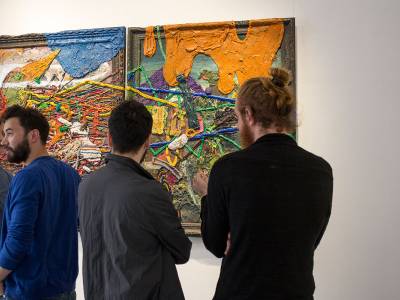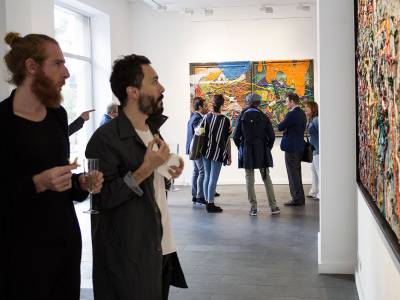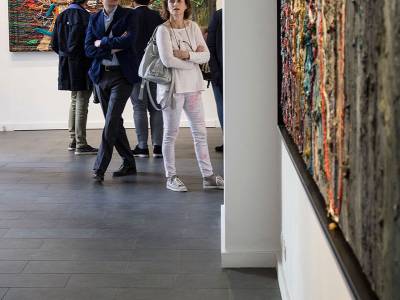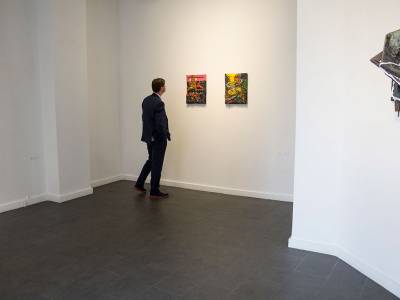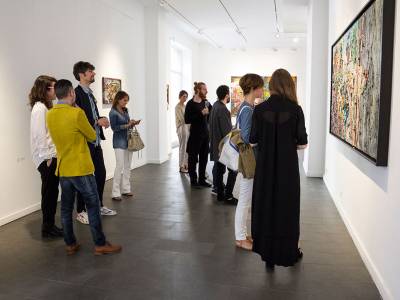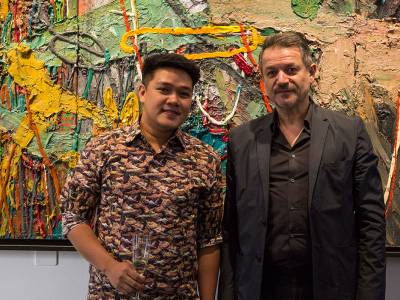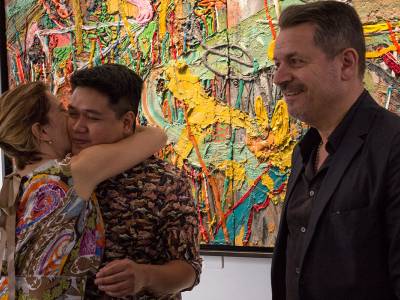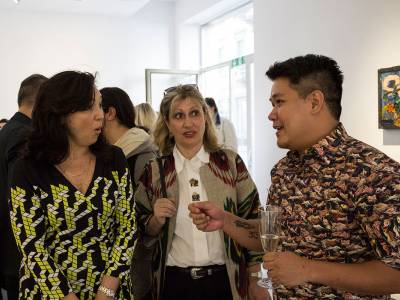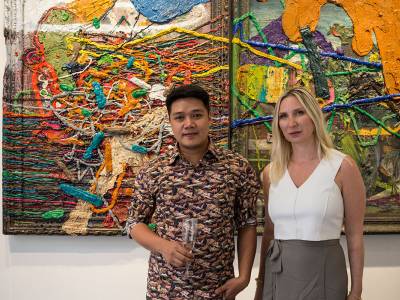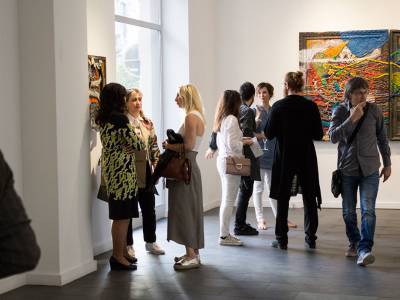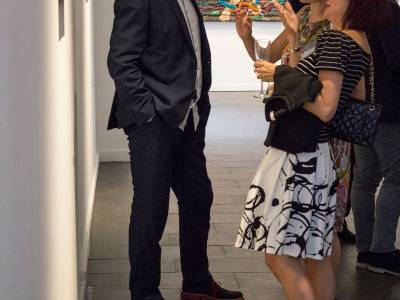Zzzzzzz…
JIGGER CRUZ IS A BEE
by Francesco Sala
There is an episode in history of art, light years away, both in a spatial and temporal sense, from the work of Jigger Cruz. But it seems to have the extraordinary elastic power of disregarding distances and bringing us to him, to his way of immersing himself in the flow of time. The Po Valley of the 7th century has nothing to do with modern day Philippines, obviously. And therefore it is a gamble to associate Jigger to the anonymous stonecutters who chisel the capitals of the crypt of Sant’Eusebio in Pavia, a very rare example of Longobard sculpture that has reached our days. What is so extraordinary about those sculptures? They are the poignant testimony of recognition - by a different kind of sensitivity – of an alien model, which is decoded in its essential elements to be finally reinterpreted, transformed and reinvented. To become something able to participate in the dual nature of the new and the old: something able to be unique.
The visual referents of those unknown masters come from frequenting a natural environment made up of herbs, birds and insects, plants and trees; apparently simple forms yet complex and articulated like fractals. The same ones that richly bloom in lush elegance in the Corinthian volutes of Asia Minor. Yet their practices, their daily way are necessarily anti-monumental, born of a nomadic culture, to a certain extent an ephemeral one. A mobile culture stemming from the eternal speed of voice and marked by ever more precious and refined small objects: the Lombards are, like many other populations which agitated Europe at that time, excellent goldsmiths. Theirs is therefore, in short, a pocketable memory.
At the time of the opportunistic conversion to Christianity, in the moment of urbanization the introduction of different communications systems became necessary. New divinities, new rites; new rites, new places of worship. From open spaces tormented by the wind of the steppes one sinks into the churches, ephemeral poles sculpted like totems, driven in the soil in order to remember the dead, giving way to columns that fulfill very different needs. And on top of those columns, clearly, are the capitals. Their forms are, however, neither Doric or Corinthian. The Longobards adopted the decorative function of an element canonized by the centuries, they took possession of its substance and stripped the flesh off its shape, they skinned it to make it anew. They tore the acanthus leaves one at a time by replacing them with geometrizing elements, triangular patterns and large comfortable longitudinal ovals which are derived directly from fibulae, from brooches, from jewelry that has always been pinned to clothes. The Lombards were goldsmiths: and goldsmiths they still are. By mixing their own tradition with another, and so giving life to a new tradition. We call it innovation.
Jigger Cruz is not at all a savage. And the mimetic process he operates with respect to art of a past very distant from him is obviously more reflective that instinctive. It is mature and conscious. Yet, digging under the conceptual force and the consciousness of his message, going beyond the formal tidiness, beyond the domain he exerts on each work, bursts uncontainable original energy which - in a way not dissimilar from those unaware artists of the past - turns consolidated tradition into compost for a new tradition. If it is true, as Novalis wrote, that “all ash is pollen”, Jigger Cruz is a bee that plunges from flower to flower, becoming loaded with a weight both sweet and heavy. That of building a world beyond, that floats equidistantly between figuration and abstraction, where the sacrifice of old idols produces new magic.
The Philippines are a peculiar nation, much closer to Europe than the kilometers that separate us. Three centuries of Spanish domination, strengthened by fifty years under the direct - and suffered - control of the United States have established cultural contacts not dissimilar from those to which we are accustomed in our latitudes. The almost epidemic spread of Catholicism has settled the visual horizon on models of the late Renaissance and Baroque; local the Academia de dibujo y pintura has educated during the nineteenth century generations of valuable painters and sculptors proposing to them the lesson of what happened in Madrid and other capitals of the Old Continent. So much so that in 1884 the dramatic Spoliarium of Filippino Juan Luna won the Gold Medal of the exhibition of Fine Arts in the Iberian capital: in the wider picture preserved today in the homeland, the artist reproduced the contempt of the centurions and the public towards the gladiators who died in the arena, deprived of their armours and dragged like beasts. A purely Western historical subject, perhaps streaked with a polemic vein – the oppressed harassed by executioners: Luna was with her brother Antonio among the activists who fought for the freedom of their country - and translated on canvas with a gritty expressiveness that reminds of Goya.
The happy subjection to more classic iconographic schemes is also a hallmark for Filipino artists who are contemporary to us: just think about the series of equestrian steampunk portraits by Jose Tence Ruiz, who is among the protagonists in 2015 of the return of his country - after half a century - at the Biennale in Venice.
Jigger Cruz, who does not deny his catholic education and explicits his fascination for the art of the past, metabolizes this welter of ideas and stimuli and treats all as his personal palimpsest, on which to write and rewrite history. “They are really obsessed” he tells “by the techniques, symbols and emotional content of ancient paintings. These are the reasons why I use them as a surface on which to paint, as elements with their own depth”. So he begins from the reproduction of genre paintings - preferably of flemish inspiration: the classic landscapes and portraits of the seventeenth century – setting them, even upside down, in frames which are often used, corrupt elements wounded by the passing of time, and transforming them into media for his explosive anarchic escape into gestural abstraction. The color, squeezed directly from tubes or sac à poche, form psychedelic vortices from electrical nuance, or pasty scratches; the thin silvery patinas shine like anodized metal, stretched almost as if the were negatives of the gold backgrounds in the blades of the 13th century. The short circuit, in the literal sense of the term, is soon made: Glitch Habitation is the title, and not by chance, in 2013, his first solo European exhibit. And by glitch we mean the imponderable and unpredictable defect that disturbs the regularity of an electrotechnical system; and by extension in electronic music - listen for example to Alva Noto and Aphex Twins - the weaving of atonal sounds born from forcing, by mistakes made in a controlled manner with samplers and digital tools.
The memory goes from here, through association of ideas, to the more recent intervention of another artist originating in South-east Asia, the Vietnamese Vö Danh, well known for his action of rethinking the memory and icons of western culture. With the Destierra los rostros sin / rewards you gracia project in winter 2015 he invaded the spaces of the Palacio de Cristal in Madrid (built in 1887, as it happens, to accommodate the Expo of the Philippine Islands), bringing Mammoth fossils, fragments of reassembled statues , archive photographs, proceeding in a discourse congenial to him and of an almost archaeological nature, proposing an anthropological analysis that in some respects reminds of Jimmie Durham. A canonized model in synthesis, universally recognized, diametrically opposed to the one pursued by Jigger Cruz: which confirms once again the originality and the novelty of his vision.
“I want to show my extreme connection with the figure and put it in a physical relationship with the surface: to break a horizon, basically” continues Cruz. Art thus becomes a form of revolution which insists toward self-determination. The attack is also ironic on preconceived codes (think of works such as The Fall of Anarchy in Western philosophy or the New Age Disco Painting, both from 2012), the ability to surf between ancient and modern, from baroque to Pop Art up to the gestural and materic abstractivism proves to be therefore a spasmodic quest for its own place in history. A chronological dimension that Jigger has always forced to his liking, even against the frantic rules of the art market: allowing himself long breaks from work, sometimes taking years to finish a single piece of work.
Showing patience and self-denial. Concentration. Qualities that belong to bees.Primae Noctis
Via Luigi Canonica 7
6900 Lugano (CH)






